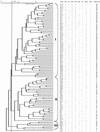Escherichia coli strains from pregnant women and neonates: intraspecies genetic distribution and prevalence of virulence factors
- PMID: 12734229
- PMCID: PMC154741
- DOI: 10.1128/JCM.41.5.1929-1935.2003
Escherichia coli strains from pregnant women and neonates: intraspecies genetic distribution and prevalence of virulence factors
Abstract
To determine the extent to which the vagina, endocervix, and amniotic fluid screen the Escherichia coli strains responsible for neonatal infections, we studied the genetic relationships among 105 E. coli strains isolated from all of the ecosystems involved in this infectious process. Twenty-four strains were isolated from the intestinal flora, and 25 strains were isolated from the vaginas of pregnant women. Twenty-seven strains were isolated from the amniotic fluid, blood, and cerebrospinal fluid (CSF) of infected neonates. The intraspecies genetic characteristics of all of the isolates were determined by random amplified polymorphic DNA (RAPD) analysis, PCR ECOR (E. coli reference) grouping, and PCR virulence genotyping. A correlation was found between the intraspecies distributions of the strains in the A, B1, B2, and D ECOR groups and in the two major RAPD groups (I and II). Nevertheless, the distribution of the E. coli strains in the RAPD groups according to their anatomical origins was more significant than their distribution in the ECOR groups. This may be explained by the existence of an E. coli subpopulation, defined by the RAPD I group, within the ECOR B2 group. This RAPD I group presents a major risk for neonates: 75% of the strains isolated from patients with meningitis and 100% of the strains isolated from patients with bacteremia were in this group. The vagina and the amniotic fluid are two barriers that favor colonization by highly infectious strains. Indeed, only 17% of fecal strains belonged to the RAPD I group, whereas 52% of vaginal strains and 67% of amniotic fluid strains belonged to this subpopulation. The ibeA and iucC genes were significantly associated with CSF strains, whereas the hly and sfa/foc genes were more frequent in blood strains. These findings could serve as a basis for developing tools to recognize vaginal strains, which present a high risk for neonates, for use in prophylaxis programs.
Figures

References
-
- Amstey, M. S., E. Lewin, and J. Colaice. 1980. Vaginal colonization with invasive Escherichia coli during pregnancy. Am. J. Obstet. Gynecol. 137:534-535. - PubMed
-
- Bingen, E., B. Picard, N. Brahimi, S. Mathy, P. Desjardin, J. Elion, and E. Denamur. 1998. Phylogenetic analysis of Escherichia coli strains causing neonatal meningitis suggests horizontal gene transfer from a predominant pool of highly virulent B2 group strains. J. Infect. Dis. 177:642-650. - PubMed
-
- Bradley, J. S. 1985. Neonatal infections. Pediatr. Infect. Dis. 4:315-320. - PubMed
-
- Cave, H., E. Bingen, J. Elion, and E. Denamur. 1994. Differentiation of Escherichia coli strains using randomly amplified polymorphic DNA analysis. Res. Microbiol. 145:141-150. - PubMed
MeSH terms
Substances
LinkOut - more resources
Full Text Sources

